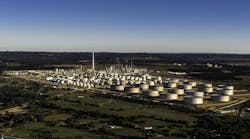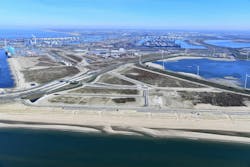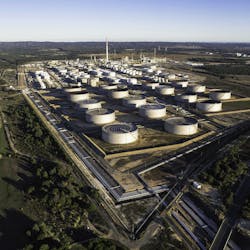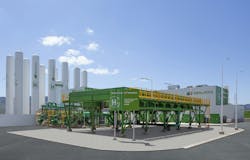The idea of integrating production plants, energy and material flow, logistics and site infrastructure isn’t new. BASF pioneered its version of this – called Verbund – at its Ludwigshafen headquarters in Germany.
Verbund is based on finding synergies for growth and sustainability by creating efficient value chains extending from basic chemicals right up to high-value-added products.
The company currently has six Verbund sites around the world. Its latest, the €10-billion ($11-billion) Zhanjiang site in China, began operation in 2022 and covers nearly 9 km2. When completed in 2030, it is expected to produce 60,000 t/yr of engineering plastic compounds, 1 million t/year of ethylene, and a variety of petrochemicals, intermediates and other products.
The area is already a center for industries such as transportation, consumer goods, and electronics, and it’s expected the investment will encourage more chemical companies and related services to begin operations there.
The success of the Verbund concept has spurred the creation of larger chemical parks, clusters and hubs around the world as companies seek ways to work together to reduce costs and improve sustainability.
The European Chemical Site Promotion Platform (ECSPP), The Hague, the Netherlands, promotes new investments in Europe's integrated, innovative and competitive chemical industrial clusters and complexes. It reports that Germany currently has 25 such clusters; France and the Netherlands five each; Belgium, Poland and Spain and the U.K. three each; Switzerland, Austria and Finland two each; and Sweden, Portugal, Ireland, Estonia, Serbia and Slovakia one each.
The substantial ongoing investment at these clusters shows how closer integration, new technologies and economies of scale are being leveraged by the European industry to meet its sustainability and profitability goals.
At the Rotterdam cluster in the Netherlands, for example, in December, Air Liquide, Paris, announced plans to build, own and operate a global carbon capture unit (CCU), leveraging its proprietary Cryocap cryogenic technology.
The CO2 will come from its existing hydrogen plant in the port of Rotterdam and, after capture, be transported through the Porthos infrastructure hub, which is currently being developed, and then permanently stored in depleted gas fields in the North Sea, approximately 20 km off the Netherlands’ coast.
Costing €500 million ($547 million), Porthos is being developed as an open-access project to capture, transport and store up to 2.5 million t/yr of CO2 produced from refineries, chemical and hydrogen plants in the Port of Rotterdam area. Rotterdam port region alone accounts for approximately 16% of the total CO2 emissions in the Netherlands (Figure 1).
The European Union (EU) has recognized Porthos as a major cross-border infrastructure project that contributes to the achievement of energy and climate policy objectives and has included it in the list of Projects of Common Interest. As such, Porthos can benefit from accelerated permitting procedures and funding.
When operational in 2026, Air Liquide’s CCU will allow it to supply the significantly decarbonized hydrogen demanded by customers.
According to Emilie Mouren-Renouard, member of Air Liquide’s executive committee and CEO of the Europe Industries Hub, it also helps the company toward its ADVANCE strategic plan to cut CO₂ emissions by 33% by 2035.
In November 2023, Air Products announced plans to build Europe’s largest blue hydrogen plant, also in the Rotterdam cluster. The new facility will include a carbon capture and CO2 treatment facility at its existing hydrogen production plant at Rotterdam and is due on stream in 2026.
The blue hydrogen produced there will serve ExxonMobil’s Rotterdam refinery and additional customers via Air Products' hydrogen pipeline network system.
The new plant also will be connected to the Porthos system.
Commenting on the new investment, Air Products COO Samir J. Serhan noted the company had been investing in Rotterdam for decades and that all companies in the cluster are continually looking for ways to collaborate, create economies of scale, drive energy efficiencies and ultimately decarbonize.
Edward Dekker Kleijn, ExxonMobil Rotterdam site manager, welcomed the collaboration with Air Products, noting that it helps the company achieve its 2050 net-zero Scope 1 and 2 emissions targets.
“This project is a great example of how industry works together to reduce carbon dioxide emissions in the Rotterdam port area,” he added.
German Sustainability Drivers
At Marl Chemical Park, the third largest integrated industrial cluster in Germany, December 2023 saw the start-up of Europe’s largest cumene facility by INEOS Phenol.
Cumene is essential to the production of phenol and the 750,000 t/yr plant will reduce CO2 emissions per ton of product by 50%.
The size of this reduction, says INEOS Phenol, is due to the combination of pioneering cumene technology and the novel heat integration network at the Marl Chemical Park.
The new plant uses existing pipeline connections between INEOS’ phenol and acetone production sites in Gladbeck, the Evonik Chempark in Marl, and the BP refinery and cracker complex in Gelsenkirchen. Most of the plant’s waste heat is used for a district heating circle, further reducing the site’s carbon footprint.
“We are investing heavily in reducing our carbon footprint when producing essential materials. We know our customers are doing the same, and supplying them with an equally strong and reliable product but with a significantly lower environmental impact is an enormous step forward,” noted INEOS Phenol operations director Hans-Juergen Bister at the plant’s inauguration.
Meanwhile, back where it all started, BASF maintains a high level of investment at its Ludwigshafen site, with two major projects being announced in November 2023.
The first is a 54 MW water electrolysis plant which will use proton exchange membrane (PEM) electrolyzer technology to produce up to 8,000 t/yr of hydrogen while reducing CO2 emissions from the site by up to 72,000 t/yr.
Known as the Hy4Chem-EI project, it moved to the next stage of construction once the German Federal Ministry for Economic Affairs and Climate Action and State of Rhineland-Palatinate agreed to provide up to €124.3 million ($136 million) in funding.
According to BASF, the Ludwigshafen site uses around 250,000 t/yr of hydrogen as a starting point in important chemical value chains. Currently, it’s mostly produced by either steam reforming or as a byproduct of other processes.
As part of its strategy to achieve net zero CO2 emissions by 2050, the company says it is testing numerous other technologies at its headquarters with the aim of replacing fossil fuels with renewable electricity. These include the demonstration plant for electrically heated steam cracker furnaces and a methane pyrolysis test plant.
Announcing the new funding, Katrin Eder, Rhineland-Palatinate’s state minister for Climate Protection, Environment, Energy, and Mobility, noted that hydrogen technology’s potential uses are many and varied and that being able to supply it cost-effectively is a key step toward establishing a sustainable hydrogen economy in Germany and the broader EU. “Last but not least, this project will help us to support Rhineland-Palatinate as a center for business and innovative strength in the long term,” she said.
BASF’s second November 2023 Ludwigshafen announcement was a “high double-digit million Euro” fermentation plant for biological and biotechnology-based crop protection products.
The plant will manufacture agricultural products, including biological fungicides and biological seed treatments (Figure 2). BASF also plans to utilize the plant to produce the main building block of Inscalis, a novel insecticide derived from a fungal strain. Commissioning is planned for the second half of 2025.
“For production at our Ludwigshafen site, this development is another step in the transition to innovative manufacturing processes with lower energy intensity based on renewable raw materials,” said Christian Aucoin, senior vice president, global operations at BASF Agricultural Solutions. “The site offers excellent synergies due to its good infrastructure, the integration into an existing high-performance production organization and the proximity of research units such as white biotechnology ,” he added.
Portugal, Spain and a Green Maritime Hydrogen Corridor
The Sines industrial and logistics zone (ZILS) in Setubal, Portugal, is the largest such area in the Iberian Peninsula.
In October 2023, MadoquaPower2X (MP2X), Lisbon, a Portuguese, Danish and Dutch international consortium led by Madoqua Renewables, said it was increasing its investment in green hydrogen and ammonia production units at ZILS from €1.3 – €2.8 billion ($1.4 – $3.1 billion).
Phase one of this will use 560 MVA of renewable electricity to produce 50,000 t/yr of hydrogen and 300,000 t/yr of green ammonia. Phase two will use an electrical connection of 1,400 MVA to produce 150,000 t/yr of hydrogen and over 1 million t/yr of green ammonia.
Non-executive director of MadoquaPower2X, Marloes Ras, stresses the ambition of the project, based on an eight-year strategic development plan, and points out that "the first phase of the project alone already corresponds to 20% of Portugal's national targets in the context of green hydrogen production at European level. The project continues to be an essential element of the producer segment to feed into the Northwest Europe hub energy receiver segment of the value chain.”
In September 2023, Repsol announced the addition of new units to its Repsol Polímeros chemical complex at ZILS.
As part of its 2050 net-zero goal, Repsol is investing €657 million ($719 million) in two new linear polyethylene and polypropylene plants.
The company, which acquired the Sines site in 2004, says the attraction of ZILS is the lack of an economic border in the EU, the complementary technologies present at its Tarragona and Puertollano sites in Spain, and the common aim of Portugal, Spain and the whole Iberian Peninsula to further develop energy and logistics integration strategies.
Also in September, energy company Galp, Lisbon, announced it will invest in two large-scale projects worth €650 million ($711 million) to reduce the carbon footprint of its ZILS refinery and associated facilities (Figure 3).
The two projects are a 270,000 t/yr advanced biofuels unit, to be built in partnership with Mitsui, and 100 MW of electrolyzers to produce green hydrogen. Both units are expected to have 2025 start-ups.
The biofuels unit will use waste residues to produce renewable diesel (hydrotreated vegetable oil) and sustainable aviation fuel, together estimated to reduce the equivalent fossil fuel emissions of CO2 by 800,000 t/yr.
The electrolysis plant will replace approximately 20% of the existing grey hydrogen consumption of the refinery, reduce CO2 emissions by an estimated 110,000 t/yr and use recycled industrial wastewater as a raw material.
Meanwhile, Spanish utility Iberdrola, Bilbao, and ACE Terminal (a collaboration between Gasunie, HES International and Vopak) are developing a green hydrogen maritime corridor between Spain and the Netherlands.
When fully up and running in 2030, Iberdrola will transport green ammonia from its Puertollano plant, Ciudad Real, Spain (Figure 4) to ACE Terminal's import facilities in the Port of Rotterdam, where it will be stored as a hydrogen carrier for customers in northwestern Europe. In addition, the terminal will provide the conversion of ammonia to hydrogen, the trans-shipment of ammonia, and the subsequent transit of hydrogen and ammonia to end users.
Transport and distribution will be through the Dutch national hydrogen network to customers in the chemical, steel, refining and fertilizer industries who are already established in clusters in locations including Rotterdam, Amsterdam, Zeeland and Chemelot in the Netherlands and in broader northwestern Europe.
Carbon Recycling in Belgium
In Belgium’s Ghent chemical cluster, ArcelorMittal and LanzaTech have successfully produced their first ethanol samples from a novel process, which is the first of its kind in the European steel industry.
Taking carbon-rich gases from ArcelorMittal’s carbon capture and utilization unit and using LanzaTech's carbon recycling process, they are converted into advanced (i.e., second-generation) ethanol.
The €200-million ($219-million) facility, called Steelanol, has the capacity to produce 80 million L/yr of advanced ethanol and is expected to reduce CO2 emissions by 125,000 t/yr. The ethanol can be used to produce sustainable transport fuels, packaging materials, apparel, and cosmetic fragrances.





